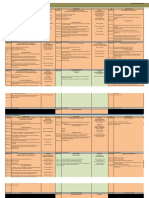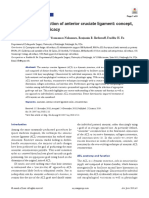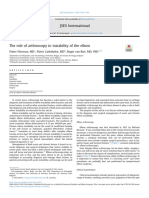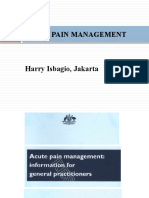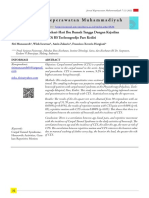TOSSM-APKASS 2020 - Conference Program
TOSSM-APKASS 2020 - Conference Program
Uploaded by
fajar alatasCopyright:
Available Formats
TOSSM-APKASS 2020 - Conference Program
TOSSM-APKASS 2020 - Conference Program
Uploaded by
fajar alatasCopyright
Available Formats
Share this document
Did you find this document useful?
Is this content inappropriate?
Copyright:
Available Formats
TOSSM-APKASS 2020 - Conference Program
TOSSM-APKASS 2020 - Conference Program
Uploaded by
fajar alatasCopyright:
Available Formats
Combined Meeting TOSSM-APKASS 2020
(9-11 July 2020)
Thursday 9 July 2020
Hall A1 Hall A2 Hall A3 Hall B1 Hall B2 Hall B3
07.30-08.30 ICL 1: Knee ICL 2: Cartilage ICL 3: Shoulder ICL 4: Elbow
ACL: Technical consideration for ACL reconstruction Decision making in treatment of chondral injury Rotator cuff Elbow instability
1. Sports specific ACL graft selection and harvesting techniques. 1. Biomechanical explanation of cartilage degeneration. 1. Rotator Cuff Repair with All-suture type anchor 1. Clinical picture and investigation.
2. Femoral and tibial tunnels: How to make it anatomic. 2. MRI in clinical practice of cartilage injury. 2. Arthroscopic rotator cuff repair: an update. 2. How to make the decision.
3. Decision for PF joint cartilage defects. 3. Treatment Technique for Large to Massive RCT. 3. Focus in medial instability.
3. ACL graft tensioning and fixation.
4. Treatment options in OCD. 4. Massive retracted cuff tears – repair techniques by release and muscle 4. Tardy posterolateral rotatory instability.
4. How can we enhance ACL graft healing and maturation. 5. Analyze and rebuild microenvironment for cartilage repair advancement.
5. ACL reconstruction in skeletal immature patients: When and why? and regeneration. 5. One step treatment for infection after rotator cuff repair. Q&A
Q&A Q&A Q&A
08.30-09.30 Knee 1 ESSKA Travelling Fellow Presentation Shoulder 1 Free Paper: Cartilage Free paper Free paper
Keynote lecture
ACL reconstruction – How to enhance the reconstruction with graft selection Instability
1. ACL reconstruction with an internal brace: When and why. “Conservative treatment of fist-time shoulder dislocation”
2. ACL reconstruction with quadriceps tendon graft. Eiji Itoi
3. Synthetic graft: Can it replace autograft? “Anterior Shoulder stabilization after Latarjet”
Yong Girl Rhee
4. Remnant preserving ACL reconstruction.
5. Double-bundle ACL reconstruction.
Q&A
09.30-10.00 Coffee Break & Exhibition
10.00-12.00 Open Ceremony
Presidential Speech
Watanabe Award Winner & Takagi Award Winner Presentation Free paper Free paper Free paper
Keynote Lecture # 1 Knee
“Osteotomy around the knee: what is known, what is new?”
Philippe Lobenhofer
Keynote Lecture # 2 Shoulder
“Tendon transfer in massive irreparable rotator cuff tear”
Bassem Elhassan
12.00-12.50 Lunch Symposium 1 Lunch Symposium 2 Lunch Symposium 3 Lunch Symposium 4 Lunch Symposium 5 Lunch Symposium 6
13.00-14.00 Knee 2 Cartilage 1 Shoulder 2 Elbow 1 Free Paper: Knee Free paper Meet the expert
Keynote lecture Evidences base on chondral injury management Instability Symposium Arthroplasty Knee
1. “ACL reconstruction: past, present, and future.” 1. Capitellar OCD in overhead athletes Lives surgery Elbow instability
Masahiro Kurosaka Arthroscopic Latarjet 1.Pathoanatomic approach for elbow instability.
2. Hip Chondral Lesions: What are options? Techniques and Outcomes
2. “Multiple ligament injuries of the knee: evidence-based treatment in 2020.” 2. Ligament reconstruction.
3. Evaluation of Knee cartilage repair results. 3.Arthroscopic LCL reconstruction.
Phillipe Neyret
4. How meniscus affects cartilage degeneration?
5. The ankle cartilage treatment trends. Q&A
Q&A
14.00-15.00 Knee 3 Cartilage 2 Shoulder 3 Elbow 2 Free Paper: Knee Free paper Meet the expert
Anterolateral complex of the knee Update in cartilage restoration Instability Symposium Arthroplasty shoulder
1. Anatomy and biomechanics of anterolateral complex. 1. Osteochondral allograft: use or not to use it. Fine tune for anterior instability of the shoulder Stiff Elbow
2. The condylar strap: a new anatomical structure in the anterolateral complex. 2. Osteochondral defect consideration when perform cartilage repair. 1.Subcritical bone loss in patients with anterior shoulder instability. 1. Stiff elbow in children: Palsy arm – Cerebral palsy.
3. Quantifying the pivot shift. 3. Regeneration of articular cartilage and meniscus using minced 2. Double pulley technique for bony Bankart with a large fragment. 2. Arthroscopic management in stiff elbow.
cartilage fragments. 3. Mini open Latarjet using one screw: Imaging assessment of the consolidation. 3. Role of osteotomy in stiff elbow.
4. Management of ACL injuries with high-grade pivot-shift phenomenon.
4. BMPs and signaling for cartilage repair. 4. Bankart v/s Latarjet: Why the disparity between Europe and rest of the world.
5. Combined ALL and ACL reconstruction: indications and outcomes. 5. Regenerative Medicine in cartilage repair. 5. Four-story anterior structure reconstruction/augmentation for recurrent Q&A
anterior shoulder dislocation.
Q&A Q&A
Q&A
15.00-15.30 Coffee Break & Exhibition
15.30-16.30 Knee 4 Cartilage 3 Shoulder 4 Elbow 3 Free Paper: Knee Free Paper Case consultation
Live cadaveric demonstration Cells and regulations Instability Athletes Elbow
My techniques in ALL reconstruction and lateral extra-articular tenodesis 1. Good practice and Regulation of Stem Cells use. Alternative procedures for treatment of anterior instability 1. Endoscopic around elbow: nerve palsy, distal biceps lesion
2. Options between bone marrow concentration vs cell expansion for 1. The early clinical results of harvest of scapular spine as graft to reconstruct the 2. Scapulothoracic relate with elbow problems.
cartilage repair. glenoid for treatment of recurrent anterior shoulder dislocation. 3. Interosseous lesion.
3. Magnetically Labeled Mesenchymal Stem Cells for cartilage repair. 2. Comparison of arthroscopic Bankart repair and open Latarjet procedure in
4. Arthroscopic for lateral epicondylitis with radiocapitellar snapping.
4. Evaluation for biologic treatments for cartilage. collision athletes.
5. Regulation of ankle cartilage recommendation. 3. Socket Bristow, 2-5 year follow up result.
4. ‘Down Under’ Lesion in shoulder instability – the overhead contact athlete. Q&A
Q&A 5. Failed Bankart repair – treatment options.
Q&A
16.30-17.15 Knee 5 Cartilage 4 Shoulder 5 Free Paper: Elbow Free Paper: Knee Free Paper Case consultation
Revision ACL reconstruction Free paper cartilage SLAP and biceps lesions
1. Why do ACL grafts fail? 1. Incidence of SLAP lesion in overhead athletes.
2. Pearls and pitfalls in single stage revision ACL reconstruction. 2. The Biceps tendon: How common is the Popeye sign? Does it affect outcomes of
3. Two stage revision ACL reconstruction: patient selection and surgical pearls cuff repair? A proposed classification of the Popeye sign.
4. Revision ACL surgery and tibial slope osteotomy 3. Anatomic concerns for SLAP repair.
4. Best practice for biceps tenodesis.
Q&A
Q&A
18.00-21.30 Presidential dinner by invitation (Bus leave hotel at 5.30 PM)
Friday. 10 July 2020
Hall A1 Hall A2 Hall A3 Hall B1 Hall B2 Hall B3
07.30-08.30 ICL 5: Knee ICL 6: Knee ICL 7: Shoulder ICL 8: Hip ICL 9
Patellar instability Limb alignment /Osteotomy Instability 1. Hip instability: What are we talking about? Frozen shoulder
1. Clinical and radiographic evaluation of patellar 1. Limb alignment and surgical planning for osteotomy Approach to posterior and multidirectional shoulder 2. Hip pain in the adolescent. All aspect about stiff shoulder
instability. around the knee. instability 3. Evaluating extra-articular hip impingement. 1. Consensus of stiff shoulder’s definition.
2. MPFL reconstruction: techniques and outcomes. 2. Osteotomy for varus OA knee. 1. Conservative treatment for MDI. 2. Genetics in Rotator Cuff Disease and Frozen Shoulder:
4.Hip arthroscopy complications: prevention and management.
3. Combined procedures for patellar instability. 3. Combined HTO and ACL reconstruction. 2. Multiple directional instability of shoulder – treatment Future applications.
strategy. Q&A
4. Options for chondral lesions in patellar instability. 4. Double osteotomy around the knee: rationale and 3. How to handle the Stiffness Related with RCT.
3. Posterior labral tears – the big masquerader a commonly
5. Revision patellofemoral surgery. technique. 4. Best practice for conservative treatment of stiff shoulder.
missed diagnosis.
Q&A 5. Computer simulation and 3D printing in HTO. 5. Surgical options for stiff shoulder.
4. Revision posterior shoulder instability repair.
Q&A Q&A
5. How do we deal with multidirectional instability in
hyperlaxity?
Q&A
08.30-09.30 Knee 6 Knee Arthroplasty 1 Shoulder 6 Hip 1 Free Paper: Shoulder Meet the expert
Live cadaveric demonstration Keynote lecture Rotator cuff Special considerations in hip arthroscopy Foot - Ankle
Arthroscopic treatment of meniscus root tear: my 1.” Potential of magnesium and its alloys for orthopaedic Salvage procedure for MIRCT 1. Hip arthroscopy in the pediatric hip.
technique in repair, reconstruction, and reduction of implants: here today and gone when you wish.“
1. Latissimus dorsal transfer for irreparable cuff tear: how we 2. Anatomic Establishment of arthroscopic portals without
extrusion. Savio Woo
do that? fluoroscopic guidance.
2. “Future of orthopaedics: where the convergence of
2. Biceps augmentation in massive rotator cuff tear: Myth or 3. Surgical management for extra-articular hip and groin injuries in
robotics and big data may be taking us.”
Savior. the athlete.
Brett Fritsch
3. Superior capsule reconstruction for reinforcement of 4. My Thai experience with peripheral compartment first.
arthroscopic rotator cuff repair.
4. Management of massive irreparable posterior superior Q&A
RCT.
5.Balloon plasty – biomechanics and clinical results.
Q&A
09.30-10.00 Coffee Break & Exhibition
10.00-11.00 Workshop Workshop Elbow 4 Hip 2 Foot Ankle 1 Free Paper: Meet the expert
Relive Surgery How I do my FAIs: planning, handling the cam and pincer, return Common problems of Achilles tendon Elbow
Tendon graft for LCL reconstruction. to sport Keynote lecture
Cadaveric demonstration: LCL reconstruction. 1. Clinical Examination and Radiology: the road to diagnosis of FAI. “Achilles Tendon pathology: the rational for treatment.”
Niek Van Dijk
2. How do I pick the winners for FAI surgery?
Q&A
3. Cam and Pincer Surgical Planning and Management.
4. Management for FAI with microinstability of the hip, anything Symposium
different? 1. Arthroscopic Treatment of Insertional Achilles Tendinopathy.
5. Arthroscopic hip revision surgery for FAI, what to look for 2. Minimally invasive Achilles tendon repair.
second time around. Q&A
Q&A
11.00-12.00 Workshop Workshop Workshop Hip 3 Foot Ankle 2 Free Paper: Shoulder Meet the expert
My surgical technique: the tips and tricks Osteochondral lesion of the talus (OLT): Shoulder
1. Labral repair: when and how. Treatment strategies
2. What I do when I see a cartilage defect. 1. Talar OCD: What We Are Doing Now?
3. Capsular management. 2. Matrix induced autogenous chondrocyte implantation for
4. The lateral hip pain. talar osteochondral lesions.
Q&A 3. Osteotomy vs non-osteotomy for deep and large lesion.
Q&A
12.00-12.50 Lunch Symposium 7 Lunch Symposium 8 Lunch Symposium 9 Lunch Symposium 10 Lunch Symposium 11 Lunch Symposium 12
13.00-14.00 Knee 7 Knee Arthroplasty 2 Shoulder 7 Sports Medicine 1 Foot Ankle 3 Free Paper Case consultation knee
Meniscus Optimizing outcomes of primary TKR Keynote lecture Understanding, prevention, treatment and rehabilitation of ACL Lateral Ankle Instability: Variety of Surgical techniques
1. Definition and classification in meniscus root tears: 1. Perioperative pain control. Rotator cuff injury - Insights from experts 1. ATFL reconstruction.
which one should be repaired? 2. Reducing blood loss and thromboprophylaxis. 1. “Reverse shoulder arthroplasty – what I have learned over 1. Prevention of ACL injury. 2. Lateral ligament reconstruction with internal brace and early
2. Meniscal extrusion: do we need to reduce it back? the past 15 years.” rehabilitation.
3. Optimal alignment in primary TKR. 2. Clinical examination of ACL - Bridging the gap.
Benjamin Ma 3. Arthroscopic Repair of lateral ankle ligament.
3. Lateral meniscus root tear: leave it in situ or repair? 4. Computer-assisted vs robotic-assisted navigation in 3. ACL injuries - current state-of-the-art.
4. Outcomes of combined osteotomy and meniscus root TKR Q&A 4. Return-to-play decisions after rehabilitation - What is missing to Q&A
repair. 5. Sports and floor activity after TKR 2. “Why and How I perform a BIO-RSA prosthesis for cuff tear prevent injuries?
5. Arthroscopic medial meniscus root reconstruction: Q&A arthropathy.” Panel Discussion: How to make it real. (15 mins)
technique and outcomes. Pascal Boileau
Q&A Q&A Q&A
14.00-15.00 Knee 8 Knee Arthroplasty 3 Shoulder 8 Sports Medicine 2 Foot Ankle 4 Thai fellow TOSSM research Case consultation
Meniscus Update on Unicompartmental knee arthroplasty Rotator cuff 14.00 - 15.00 Common foot and ankle injury in runner and dancer presentation knee
Decision making for meniscus tears 1. UKA vs HTO: patient selection and outcomes. Cadaveric live surgery: Preventive sports medicine 1. The long-term fate of bone bruises.
1. Chronic locked meniscus: cut it or save it? 2. Cemented, cementless, and hybrid UKA: patient “What, Why and How of cardiopulmonary exercise testing in 2. Foot and ankle injuries in dancers.
Lower trapezius transfer for posterosuperior cuff tear.
2. Horizontal cleavage of the meniscus: should we repair? sports medicine” 3. Stress fractures in runner.
selection and outcomes
3. Why do we have to repair the ramp lesion and how?. Q&A Q&A
3. How to minimize complication and improve longevity
4. Hypermobile meniscus: what should we do? of UKA
5. Meniscal allograft transplantation: techniques and 4. UKA using computer assisted surgery and robotics
outcomes. 5. Same day surgery in UKA
Q&A Q&A
15.00-15.30 Coffee Break & Exhibition
15.30-16.30 Knee 9 Free Paper: Knee /Knee arthroplasty Shoulder 9 Sports Medicine 3 Foot & Ankle 5 Thai fellow TOSSM research Case consultation
Medial Side injury Basix science and clinical related Workshop Cadaveric Demonstration presentation
1. Anatomy of the medial structures of the knee: a 1. Functional anatomy of the shoulder. Workshop: Cardiopulmonary test 1. Hindfoot endoscopy.
rationale for repair and reconstruction. 2. Enhancement of Bone Tendon Healing on Rotator Cuff “How to carry out cardiopulmonary stress test in clinical setting” Q&A
2. Biomechanic of medial structure. repair.
3. Acute management of MCL injury. 3. Tear progression in rotator cuff tears; How, when, and how Q&A 2. Arthroscopic Brostrom repair.
4. Treatment algorithm for chronic MCL injury. much speed tears progress? Q&A
5. Medial collateral ligament reconstruction: technique 4. Efficacy of PRP in arthroscopic repair of full-thickness
and outcomes. rotator cuff tear.
Q&A 5. Rotator Cuff injuries – what did we learn with the MOON
group.
Q&A
16.30-17.15 Knee 10 Free Paper: Knee /Knee arthroplasty Shoulder 10
APKASS ACL Consensus Rotator cuff reparability
1. Evaluation of risk factors for irreparable rotator cuff tear in
patients older than age 70 including evaluation of radiologic Free paper Free Paper: Knee Case consultation
factors. Foot & Ankle shoulder
2. The rotator cuff healing index.
3. Reparability assessment score for rotator cuff tears and
related preoperative factors.
4. Rotator cuff repair based on our anatomic studies - from
small to massive tear.
Q&A
18.30-21.30 Congress Dinner
Saturday. 11 July 20120
Hall A1 Hall A2 Hall A3 Hall B2
08.00-09.00 ICL 10: Sports Medicine ICL 11: Knee Arthroplasty ICL 12: Shoulder ICL13: Foot Ankle
What is new in Sports medicine? The difficult primary TKR Shoulder Arthroplasty 1. Advancement of hindfoot endoscopy.
1. Evaluation and management in proximal hamstring injury. 1. Severe varus and valgus deformity 1. Clinical results of medialized vs lateralized RSA. 2. Management of chronic Achilles tendon rupture with large gap.
2. Rehabilitation in hamstring strain in athlete. 2. Primary TKR in the ankylosed knee. 2. Biomechanics for RTSA system for treatment of cuff tear arthropathy. 3. Management of recalcitrant plantar fasciosis.
3. Indications and outcomes of surgical management in proximal hamstring injury. 3. Dealing with extra-articular deformity in primary TKR. 3. Management of glenoid bone loss in RTSA. Q&A
4. Technical not in proximal hamstring avulsion injury. 4. Bilateral simultaneous total knee replacement. 4. Restoring external rotation strength with RTSA: when and how?
5. Failed osteotomy around the knee: what should we do next? 5. Combined SCR and anatomical TSA as alternative to RTSA.
Q&A Q&A
09.00-10.00 Knee 11 Knee Arthroplasty 4 Shoulder 11 Free Paper: Knee
Keynote lectures Infected total knee arthroplasty Shoulder arthroplasty
1. The anterolateral ligament of the knee: lessons learned and the way to go. 1. Prevention of infected TKR. Complicated shoulder arthroplasty
Betrand Sonnery-Cottet 2. Update in diagnosis of infected TKR. 1. Instability after shoulder arthroplasty: when to occur & how to avoid.
2. Management of deltoid deficiency in patients with shoulder arthritis or Patients who had
2. Habitual patellar dislocation: A La Carte surgical treatment. 3. Debridement and polyethylene exchange.
prior RSA.
Feng Hua 4. Using cement spacer in PJI: techniques and outcomes 3.Infection after RSA.
5. Single-stage revision TKR. 4.Revision RSA.
Q&A Q&A
10.00-10.30 Coffee Break& Exhibition
10.30-11.30 Knee 12 Knee Arthroplasty 5 Shoulder 12 Free Paper: Miscellaneous
Patellar instability Revision total knee arthroplasty Rotator cuff
1. How far can the indications of isolated MPFL reconstruction be pushed? 1. Flexion instability. Issues of subscapularis tear
2. The optimal graft fixation points in MPFL reconstruction. 2. Global instability. 1. Arthroscopic subscapularis repair: technical pearls and outcomes.
2. Subscapularis tear – when to be repaired or reconstructed?
3. Quads technique for MPFL reconstruction. 3. Stiff knee.
3. Hidden lesion of subscapularis tendon tear and biceps subluxation.
4. Trochleoplasty: technique and outcomes. 4. Bone loss 4. Clinical outcomes and tendon integrity in patients with chronic retracted subscapularis
5. Bony surgery in patellar instability. 5. Previous scar and soft tissue defect. tear after arthroscopic single-row oblique mattress suture.
Q&A Q&A 5. Irreparable subscapularis- any salvage options.
Q&A
11.30-12.30 Knee 13 Meet the Expert 1: Trauma Shoulder 13 Free Paper: Miscellaneous
Arthroscopic PCL reconstruction Periprosthetic fracture around the knee Shoulder pain
1. Arthroscopic PCLR: all inside technique with internal brace augmentation. 1. Periprosthetic femoral fracture: update on fixation. 1.Management of scapulothoracic disorders.
2. Single-bundle PCLR with remnant preservation. 2. Interprosthetic femoral fracture: How to deal with. 2. Strategy for shoulder pain in overhead athletes.
3. Double-bundle PCLR. 3. Periprosthetic patellar fracture: Surgical tips and tricks. 3. Scapular dyskinesis after chronic ACJ injury.
4. Arthroscopic PCL tibial inlay reconstruction. 4. Periprosthetic tibia fracture: update on fixation. 4. Thoracic Outlet Syndromes: Endoscopic First Rib Resection.
5. Periprosthetic fracture in UKA: Plate vs. Screw. Q&A
5. Failed PCL reconstruction: why and what’s next?
Q&A Q&A
12.30-13.30 Lunch symposium Lunch symposium Lunch symposium Lunch symposium
13.30-14.30 Knee 14 Meet the Expert 2: Trauma Shoulder 14
Posterolateral-side knee injury Tibial plateau fracture Shoulder arthritis in the young
1. Structures and biomechanics of the posterolateral corner: rationale of treatment. 1. Complex tibial plateau: Why posterior? 1. Alternative surgery out of arthroplasty for shoulder arthritis in the young.
2. Intra- and extraarticular osteotomy in posttraumatic malunions. 2. Stemless shoulder replacement: concepts and design rationales.
2. Evidences base review of acute repair vs. acute reconstruction.
3. Arthroscopy-Assisted Corrective Osteotomy for Tibial Plateau Malunions. 3. Management of shoulder arthritis in the young patient.
3. Treatment algorithm for posterolateral rotatory instability.
4. Anatomic PLC reconstruction with partial peroneus longus tendon. 4. Special consideration for treatment of should arthritis from AVN and rheumatoid
5. Roles of osteotomy for chronic lateral-side knee injury. arthritis in young patients.
Q&A 5. Pyrotitan pyrocarbon for hemiarthroplasty humeral head – clinical results.
Q&A
14.30-15.30 Knee 15 Meet the Expert 3: Trauma Shoulder 15
Multiple ligament injuries Proximal humeral fracture: comprehensive approach ACJ injury
1. Multiple ligament injuries of the knee: injury patterns, management and outcomes. 1. Proximal humerous fracture: principles and keys of management. 1. Anatomy and reconstruction of AC joints in Asians.
2. Roles of a new clinical classification for multiple ligament injuries and associated treatment 2. Third generation IM mail for treatment of proximal humeral fracture. 2. Acromioclavicular joint injuries in the contact athlete.
protocol. 3. New innovative technique for management of displaced fractures of proximal humerous. 3. All-arthroscopic reconstruction of severe chronic acromioclavicular joint dislocations.
4. Arthroplasty for proximal humeral fracture.
3. Management of fracture-dislocation of the knee. 4. Open coracoclavicular ligament and acromioclavicular ligament reconstruction.
5. Arthroscopic assisted tuberosity fixation.
4. Treating multiple ligament injuries in competitive athletes. 5. Does anatomic CC reconstruction prevent further instability compare to other
Q&A
5. Management of chronic knee dislocation. techniques?
Q&A Q&A
Adjourn
Welcome & Orientation for The New Fellow
You might also like
- Clinical Teaching Plan SampleDocument9 pagesClinical Teaching Plan SampleChristian Felix Ignacio75% (12)
- Low Self Esteem: A Map of The Territory: Early ExperienceDocument1 pageLow Self Esteem: A Map of The Territory: Early ExperiencenoradeenNo ratings yet
- 311 WI Syllabus Spring 2019Document10 pages311 WI Syllabus Spring 2019Pablo FurukawaNo ratings yet
- 2018 - RCOST - Scientific ProgramDocument17 pages2018 - RCOST - Scientific ProgramGym NoppadonNo ratings yet
- Joshi & Nagmani, 2019Document24 pagesJoshi & Nagmani, 2019Salsabila Kusuma JannatiNo ratings yet
- Current Concepts of Posterolateral Corner Injuries of The Knee 2017Document13 pagesCurrent Concepts of Posterolateral Corner Injuries of The Knee 2017Mohan DesaiNo ratings yet
- 1 s2.0 S2212628724002147 MainDocument6 pages1 s2.0 S2212628724002147 MainJAVIER FAUS COTINONo ratings yet
- 1 s2.0 S2212628723000269 MainDocument7 pages1 s2.0 S2212628723000269 MainYordhanno Xavier Fallaque RuizNo ratings yet
- Total Shoulder Arthroplasty, An Overview, Indicatins and Prosthetic OptionsDocument4 pagesTotal Shoulder Arthroplasty, An Overview, Indicatins and Prosthetic OptionsYafiahnaf FirdausNo ratings yet
- Acta Scientific Total Knee Arthroplasty in Ankylosed Knee With Fracture Supracondylar FemurDocument7 pagesActa Scientific Total Knee Arthroplasty in Ankylosed Knee With Fracture Supracondylar FemurMihir Ranjan RoutNo ratings yet
- Anterolateral Ligament Reconstruction Technique An Anatomic BasedDocument5 pagesAnterolateral Ligament Reconstruction Technique An Anatomic BasedEmilio Eduardo ChoqueNo ratings yet
- Final Thesis (Dr. Neeraj)Document79 pagesFinal Thesis (Dr. Neeraj)Prosenjit BhowalNo ratings yet
- Medial Femoral Condyle Fracture During An Oxford UDocument3 pagesMedial Femoral Condyle Fracture During An Oxford Uestefania1994No ratings yet
- Current Concepts on Unicompartmental Knee.1Document6 pagesCurrent Concepts on Unicompartmental Knee.1Matej MilošNo ratings yet
- Ligament Balancing Medial Stabilising TechniqueDocument6 pagesLigament Balancing Medial Stabilising TechniqueMohan DesaiNo ratings yet
- Bankart RepairDocument5 pagesBankart RepairphantomkatalynNo ratings yet
- Effect of The Iliotibial Band On Knee Biomechanics During ADocument7 pagesEffect of The Iliotibial Band On Knee Biomechanics During ADani JelaNo ratings yet
- Anatomic Reconstruction of Anterior Cruciate LigamentDocument9 pagesAnatomic Reconstruction of Anterior Cruciate LigamentOthoniel RamirezNo ratings yet
- 7 ACL Single Bundle ReconstructionDocument28 pages7 ACL Single Bundle ReconstructionAgung TristyantoNo ratings yet
- Main. Condromalacia RotulianaDocument4 pagesMain. Condromalacia RotulianaCarmen LaterazaNo ratings yet
- Anterior Cable Reconstruction Using Autologous Long Head of The Biceps Tendon For Massive Irreparable Rotator Cuff TearsDocument11 pagesAnterior Cable Reconstruction Using Autologous Long Head of The Biceps Tendon For Massive Irreparable Rotator Cuff TearsjulioNo ratings yet
- Cope Land Op TechDocument24 pagesCope Land Op Techsiddig7No ratings yet
- PDF 5Document49 pagesPDF 5Amina GoharyNo ratings yet
- Mucoid Degeneration of Anterior Cruciate Ligament—A Systematic Approach for DebulkingDocument6 pagesMucoid Degeneration of Anterior Cruciate Ligament—A Systematic Approach for DebulkingAn DuyNo ratings yet
- Kawaguchi et al 2015Document10 pagesKawaguchi et al 2015BarbuSorinNo ratings yet
- Chronic Ankle InstablityDocument25 pagesChronic Ankle InstablityPatricia RuthNo ratings yet
- The Role of Arthroscopy in Instability of The Elbow 2023 JSES InternationalDocument6 pagesThe Role of Arthroscopy in Instability of The Elbow 2023 JSES Internationaligor gayosoNo ratings yet
- Bleazey-2012-Recon of Complex Oc Lesions of The Talus With Cylindrical Sponge Allograft and Particulate Juvenile Cartilage GraftDocument7 pagesBleazey-2012-Recon of Complex Oc Lesions of The Talus With Cylindrical Sponge Allograft and Particulate Juvenile Cartilage Graftapi-212907483No ratings yet
- Research Article: Anatomical Consideration of The Anterolateral Ligament of The KneeDocument6 pagesResearch Article: Anatomical Consideration of The Anterolateral Ligament of The KneetanyasisNo ratings yet
- Journal of Clinical Neuroscience: Michael Mokawem, Galateia Katzouraki, Clare L. Harman, Robert LeeDocument6 pagesJournal of Clinical Neuroscience: Michael Mokawem, Galateia Katzouraki, Clare L. Harman, Robert Leeridwan hardiNo ratings yet
- Schlund 2019Document3 pagesSchlund 2019mesescuNo ratings yet
- Mandibular Orthognathic ProceduresDocument104 pagesMandibular Orthognathic ProceduresDrSusmi ChebroluNo ratings yet
- Arthroscopic Fixation of Anterior Cruciate Ligament Tibial Avulsion Fractures Using Fibre Wire With EndobuttonDocument6 pagesArthroscopic Fixation of Anterior Cruciate Ligament Tibial Avulsion Fractures Using Fibre Wire With EndobuttonQamar AzeezNo ratings yet
- PROSPECTIVE STUDY OF FUNCTIONAL OUTCOME OF ARTHROSCOPIC ANTERIORCRUCIATE LIGAMENT RECONSTRUCTION WITH PERONEUS LONGUS AUTOGRAFTDocument6 pagesPROSPECTIVE STUDY OF FUNCTIONAL OUTCOME OF ARTHROSCOPIC ANTERIORCRUCIATE LIGAMENT RECONSTRUCTION WITH PERONEUS LONGUS AUTOGRAFTIJAR JOURNALNo ratings yet
- Reconstruction Options and Outcomes For Acetabular Bone Loss in Revision Hip ArthroplastyDocument7 pagesReconstruction Options and Outcomes For Acetabular Bone Loss in Revision Hip ArthroplastyMohan DesaiNo ratings yet
- TALLO UCP UnitedDocument14 pagesTALLO UCP UnitedanaluciamirallasNo ratings yet
- 1 s2.0 S1010518218307194 MainDocument12 pages1 s2.0 S1010518218307194 MainEnes KayaNo ratings yet
- A Technical Tip To Treat The Intraoperative Lateral Cortex Fracture During A Medial Open Wedge High Tibial OsteotomyDocument5 pagesA Technical Tip To Treat The Intraoperative Lateral Cortex Fracture During A Medial Open Wedge High Tibial OsteotomyAthenaeum Scientific PublishersNo ratings yet
- Yamazaki 2021Document6 pagesYamazaki 2021Nelson Guerra ZabaletaNo ratings yet
- Tka ValgusDocument11 pagesTka ValgusOvidiu RusuNo ratings yet
- Ankle Arthritis AcfasDocument13 pagesAnkle Arthritis AcfasRoger NguyenNo ratings yet
- 8 ACL Double Bundle Reconstruction - DNUDocument43 pages8 ACL Double Bundle Reconstruction - DNUAgung TristyantoNo ratings yet
- Stephen 2015Document9 pagesStephen 2015Rui ViegasNo ratings yet
- International Journal of Surgery Case ReportsDocument5 pagesInternational Journal of Surgery Case Reports'fanny Quenhita'No ratings yet
- Ortho DNB PrpapDocument12 pagesOrtho DNB PrpapRaj KumarNo ratings yet
- PIIS2352344120300613Document5 pagesPIIS2352344120300613yu prdnyaNo ratings yet
- Mar2012 CCDocument12 pagesMar2012 CCJavierLarenasNo ratings yet
- Kadhim (2018)Document8 pagesKadhim (2018)Fernanda LealNo ratings yet
- Kenter SHOULDER INSTABILITY IN PATIENTS WITH EDSs PDFDocument3 pagesKenter SHOULDER INSTABILITY IN PATIENTS WITH EDSs PDFMagedNo ratings yet
- Hook Plating in Patella FracturesDocument5 pagesHook Plating in Patella FracturesAldrovando JrNo ratings yet
- ACL TearsDocument11 pagesACL TearsAhmed SharafNo ratings yet
- All-Insideposteriorcruciate Ligamentreconstruction: Surgical Technique and OutcomeDocument11 pagesAll-Insideposteriorcruciate Ligamentreconstruction: Surgical Technique and OutcomedrbaneNo ratings yet
- Arthroscopic Elbow Debridement Using Anterocentral Transbrachialis PortalDocument6 pagesArthroscopic Elbow Debridement Using Anterocentral Transbrachialis PortalMoustafa MohamedNo ratings yet
- Our Experience On Peroneus Longus As Graft For Arthroscopic ACL ReconstructionDocument9 pagesOur Experience On Peroneus Longus As Graft For Arthroscopic ACL ReconstructionInternational Journal of Innovative Science and Research TechnologyNo ratings yet
- Graft Choice 3Document8 pagesGraft Choice 3brain jackNo ratings yet
- Gallo 2017Document7 pagesGallo 2017Prem Raj ACNo ratings yet
- Curriculum Vitae Curtis R. Noel, MD: Education FellowshipDocument5 pagesCurriculum Vitae Curtis R. Noel, MD: Education FellowshipJalel SaidiNo ratings yet
- Posteromedial KneeDocument4 pagesPosteromedial KneeawkashNo ratings yet
- The Knee: S.L. Keays, M. Sayers, D.B. Mellifont, C. RichardsonDocument10 pagesThe Knee: S.L. Keays, M. Sayers, D.B. Mellifont, C. Richardsonakfis ukiNo ratings yet
- J Jbiomech 2019 01 023 PDFDocument7 pagesJ Jbiomech 2019 01 023 PDFArchita AgarwalNo ratings yet
- 6 BDCDocument5 pages6 BDCtuấn phanNo ratings yet
- Finite Element Analysis On Knee Joint For Knee OA PatientsDocument5 pagesFinite Element Analysis On Knee Joint For Knee OA PatientsMoustafa AnwarNo ratings yet
- Anterior Cruciate Ligament Reconstruction: A Practical Surgical GuideFrom EverandAnterior Cruciate Ligament Reconstruction: A Practical Surgical GuideNo ratings yet
- 1st Announcement COE PABOI Ke 67 PDFDocument25 pages1st Announcement COE PABOI Ke 67 PDFfajar alatasNo ratings yet
- Control of Blood Pressure in Hypertensive Neurological EmergenciesDocument11 pagesControl of Blood Pressure in Hypertensive Neurological Emergenciesfajar alatasNo ratings yet
- Materi 1 Prof. Dr. Dr. Darwin, SP.S (K), FAANDocument54 pagesMateri 1 Prof. Dr. Dr. Darwin, SP.S (K), FAANfajar alatasNo ratings yet
- Acute Pain Management, TIR Jakarta 20 April 2013Document47 pagesAcute Pain Management, TIR Jakarta 20 April 2013fajar alatasNo ratings yet
- Literatur Tentang AllergiDocument9 pagesLiteratur Tentang Allergifajar alatasNo ratings yet
- User Instructions: Installation Operation MaintenanceDocument48 pagesUser Instructions: Installation Operation MaintenanceYerko NavarroNo ratings yet
- Chalk Mixture ResearchDocument2 pagesChalk Mixture ResearchYuuki Cross75% (4)
- Protocol For A Systematic Review of "Lotus Birthing Method: Friend or Foe"Document4 pagesProtocol For A Systematic Review of "Lotus Birthing Method: Friend or Foe"International Journal of Innovative Science and Research TechnologyNo ratings yet
- 08 - Chapter 2Document31 pages08 - Chapter 2Varun Mohandas0% (1)
- Lecture 8Document42 pagesLecture 8Yong Hao Jordan JinNo ratings yet
- STR SIZ Hit Points DEX APP Luck INT EDU Sanity CON POW Magic PointsDocument3 pagesSTR SIZ Hit Points DEX APP Luck INT EDU Sanity CON POW Magic PointsArthur NunesNo ratings yet
- Sources of Research ProblemDocument13 pagesSources of Research ProblemMary Grace Jerna Artazo Nozal-Cuadra100% (2)
- Childhood Obesity Thesis Statement EssayDocument5 pagesChildhood Obesity Thesis Statement Essayangieleeportland100% (1)
- Criminology and Its Implications On Public PolicyDocument4 pagesCriminology and Its Implications On Public PolicyAdan HoodaNo ratings yet
- Safety Pledge and Liability Waiver: Candlelight (The "Experience")Document3 pagesSafety Pledge and Liability Waiver: Candlelight (The "Experience")Felicitas Fernandez de MaussionNo ratings yet
- Tuyen Tap Cac de Da Thi Phan Thi Viet Vstep B1 B1 C1Document40 pagesTuyen Tap Cac de Da Thi Phan Thi Viet Vstep B1 B1 C1Nguyên LêNo ratings yet
- Pengaruh Pemasangan Poster Anjuran Buang Sampah Terhadap Pemanfaatan Tempat Sampah Di Tempat WisataDocument12 pagesPengaruh Pemasangan Poster Anjuran Buang Sampah Terhadap Pemanfaatan Tempat Sampah Di Tempat WisataRolan Mart SasongkoNo ratings yet
- Biolife Medical PVT LTD: D 31, Site Iv, Kasna, Greater Noida 201 306, U. P., IndiaDocument1 pageBiolife Medical PVT LTD: D 31, Site Iv, Kasna, Greater Noida 201 306, U. P., IndianishthaNo ratings yet
- 1 PBDocument5 pages1 PBPos Kesehatan GBBNo ratings yet
- SWMS Cherry PickerDocument15 pagesSWMS Cherry Pickervictor0% (1)
- DNB Orthopaedics PaperDocument4 pagesDNB Orthopaedics PaperRahul RoyNo ratings yet
- Assessment Nursing Diagnosis Planning Nursing Intervention Rationale Evaluation Subjective: Long Term: Long TermDocument2 pagesAssessment Nursing Diagnosis Planning Nursing Intervention Rationale Evaluation Subjective: Long Term: Long TermAriaNo ratings yet
- Lalana Newborn ResuscitationDocument55 pagesLalana Newborn ResuscitationAthenaeum Scientific PublishersNo ratings yet
- PL 600 (Sanitizer and Disinfectant TabletsDocument9 pagesPL 600 (Sanitizer and Disinfectant TabletsYJ WangNo ratings yet
- B. Scheduling Schedule: Be Determined With A Simple Worker-Patient Ratio or FormulaDocument7 pagesB. Scheduling Schedule: Be Determined With A Simple Worker-Patient Ratio or FormulaYmon TuallaNo ratings yet
- 1revised Final Exam Schedule For NS Freshman Students, 2021Document12 pages1revised Final Exam Schedule For NS Freshman Students, 2021hiwot wonagoNo ratings yet
- BurnsDocument13 pagesBurnsMatiuta SorinNo ratings yet
- Male Genitalia Clinical - Physical Examination - Mark H. SwartzDocument3 pagesMale Genitalia Clinical - Physical Examination - Mark H. Swartzmaha candraNo ratings yet
- Practice Test 6 StudentsDocument9 pagesPractice Test 6 StudentsRikki RoukiNo ratings yet
- HDPE Plastic PIPE FUSION WELDING WORK METHOD STATEMENT 01 PDFDocument11 pagesHDPE Plastic PIPE FUSION WELDING WORK METHOD STATEMENT 01 PDFSuryakant Suraj100% (2)
- Purchase Request SampleDocument1 pagePurchase Request SampleHelen Paragas Solivar AranetaNo ratings yet
- Learning About HIV: A Lesson Plan From Rights, Respect, Responsibility: A K-12 CurriculumDocument7 pagesLearning About HIV: A Lesson Plan From Rights, Respect, Responsibility: A K-12 CurriculumRazell Jean ArazaNo ratings yet



